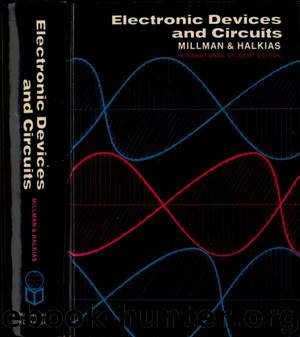Electronic Devices & Circuits by Jacob Millman & Christos C. Halkias

Author:Jacob Millman & Christos C. Halkias
Language: eng
Format: epub
Tags: Electronics; Valve; Tube; Diode; Transistor; Biasing; Field Effect; Amplifiers; LF; HF
362 / ELECTRONIC DEVICES AND CIRCUITS
S«c. !2. ? j
to construct a difference amplifier with Ql and Q2 having almost identical properties. Under these conditions any parameter changes due to tempera-ture will cancel and will not vary the output. A number of manufacturers t sell devices designed specifically for difference-amplifier applications. These consist of two high-gain n-p-n silicon planar transistors in the same hermetically sealed enclosure. The manufacturer guarantees that for equality 0 f collector currents the maximum difference in base voltages is 5 mV, that the base-voltage differential at fixed collector current will not exceed 10 juV/°C and that h fe of one transistor will not differ from h ft of the other by more thao 10 percent. It has been found 7 that a substantial reduction in thermal drift is obtained if the two transistors are operated with equal V B s instead of equal collector current.
Difference amplifiers may be cascaded in order to obtain larger amplifi, cations for the difference signal and also better common-mode rejection. Outputs V a i and V o2 are taken from each collector (Fig. 12-23) and are coupled directly to the two bases, respectively, of the next stage.
Finally, the differential amplifier may be used as an emitter-coupled phase inverter. For this application the signal is applied to one base, whereas the second base is not excited (but is, of course, properly biased). The output voltages taken from the collectors are equal in magnitude and 180° out of phase.
REFERENCES
1. Coblenz, A., and H. L. Owens: Cascading Transistor Amplifier Stages, Electronics, vol. 27, pp. 158-161, January, 1954.
2. Dion, D. F,: Common Emitter Transistor Amplifiers, Proc, IRE, vol. 46, p. 920, May, 1958.
3. Miller, J. M.: Dependence of the Input Impedance of a Three-electrode Vacuum Tube upon the Load in the Plate Circuit, Nail. Bur. Std. (U.S.) Res Papers vol. 15, no. 351, pp. 367-385, 1919.
4. Levirie, I.: High Input Impedance Transistor Circuits, Electronics, vol. 33, pp. 50-54, September, 1960.
5. James, J. R.: Analysis of the Transistor Cascode Configuration, Electron. EnQ-> vol. 32, pp. 44-48, 1960.
6. Slaughter, D. W.: The Emitter-coupled Differential Amplifier. IRE Trans. Circuit Theory, vol. CT-3, pp. 51-53, 1956.
Middlebrook, R. D.: Differential Amplifiers, John Wiley & Sons Inc New York, 1963.
7. Hoffait, A. H., and R. D. Thornton: Limitations of Transistor DC Amplifi"* 9 ' Proc. IEEE, vol. 52, no. 2, pp. 179-184, February, 1964.
t Fairchild Semiconductor Corporation, Sprague Electric Co., Texas Instruments, Ii» c "» and Motorola, Inc.
13/THE HIGH-FREQUENCY TRANSISTOR
At low frequencies it is assumed that the transistor responds instantly to changes of input voltage or current. Actually, such is not the case because the mechanism of the transport of charge carriers from emitter to collector is essentially one of diffusion. Hence, in order to find out how the transistor behaves at high frequencies, it is necessary to examine this diffusion mechanism in more detail. Such an analysis 1 is complicated, and the resulting equations are suggestive of those encountered in connection with a lossy transmission line. This result could have been
Download
This site does not store any files on its server. We only index and link to content provided by other sites. Please contact the content providers to delete copyright contents if any and email us, we'll remove relevant links or contents immediately.
| Circuits | Digital Design |
| Electric Machinery & Motors | Electronics |
| Fiber Optics | Networks |
| Superconductivity |
Whiskies Galore by Ian Buxton(41034)
Introduction to Aircraft Design (Cambridge Aerospace Series) by John P. Fielding(32442)
Small Unmanned Fixed-wing Aircraft Design by Andrew J. Keane Andras Sobester James P. Scanlan & András Sóbester & James P. Scanlan(32199)
Craft Beer for the Homebrewer by Michael Agnew(17523)
Turbulence by E. J. Noyes(7177)
The Complete Stick Figure Physics Tutorials by Allen Sarah(6724)
Kaplan MCAT General Chemistry Review by Kaplan(6147)
The Thirst by Nesbo Jo(5881)
Bad Blood by John Carreyrou(5864)
Learning SQL by Alan Beaulieu(5537)
Weapons of Math Destruction by Cathy O'Neil(5163)
Man-made Catastrophes and Risk Information Concealment by Dmitry Chernov & Didier Sornette(4886)
iGen by Jean M. Twenge(4770)
Digital Minimalism by Cal Newport;(4734)
Life 3.0: Being Human in the Age of Artificial Intelligence by Tegmark Max(4605)
Audition by Ryu Murakami(4185)
Electronic Devices & Circuits by Jacob Millman & Christos C. Halkias(4149)
1,001 ASVAB Practice Questions For Dummies by Powers Rod(4118)
Pale Blue Dot by Carl Sagan(4114)
